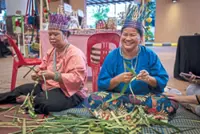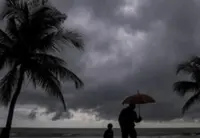Rusli says poorly managed tourism activities threaten the survival of Rafflesia. — Photos: Bernama and file photos
THE morning sun casts a soft glow through the dense greenery of Kelantan’s Lojing rainforest, as hikers make their way up the mountain range.
Accompanied by Rusli Angah, 43, a Temiar Orang Asli guide, the group treks towards their destination – the Rafflesia Conservation Area located about 350m above sea level.
Their quest: To find a blooming Rafflesia.
Having lived near the Lojing rainforest for over 20 years, Rusli leads the group with confidence.
After nearly two hours of hiking, he points to a breathtaking sight on the forest floor – surrounded by a blanket of dry leaves, a single Rafflesia bloom with five brick-red petals speckled in white stands proudly, facing the sky.
Called the “corpse flower” due to its foul smell resembling rotting flesh, it has no leaves, stems or roots of its own.
Instead, it lives as a parasitic organism, attaching itself to the roots of other plants to extract nutrients from its host.
As of October 2020, the Plants of the World Online website has listed over 40 species of Rafflesia, all of which are found in Peninsular Malaysia, Borneo (including Sabah and Sarawak) and the Philippines.
In the peninsular, nine species have been identified, with three – Rafflesia kerri, Rafflesia cantleyi and Rafflesia su-meiae – found in the state of Kelantan.
Tribal significance
Beyond its scientific characteristics, the Rafflesia holds deep cultural meaning for local Orang Asli communities, especially the Temiar and Jahai tribes.
They believe the flower possesses a spirit and serves as an indicator of the forest ecosystem’s health.
“Before entering a Rafflesia habitat, some Orang Asli groups perform rituals or seek permission from the forest spirits to ensure the harmony of nature is not disturbed,” said Rusli.
Additionally, the Rafflesia is seen as a sign of environmental change.
Rusli said the Orang Asli believed a sudden abundance of blooming Rafflesia might signal prolonged rainy seasons or significant ecological shifts.
Certain parts of the flower, including its roots, are believed to have medicinal properties, particularly in treating women after childbirth.
According to Rusli, a decoction made from the flower is used to help accelerate uterine contraction and restore a mother’s energy.
He said the use of the flower in traditional medicine also extended to treating fevers and boosting the immune system.
However, he said the community’s use of Rafflesia was tightly controlled and guided by the belief that overexploitation could bring harm.
They believe that harvesting the flower without good reason or in excessive amounts can upset the natural balance and bring misfortune.
Keys to conservation
The Orang Asli also play a key part in conserving the Rafflesia’s natural habitat.
As the original inhabitants of the forest, they are the first line of defence in detecting threats to the flower, such as illegal logging, land encroachment, and unregulated tourism.
Rusli said the Orang Asli were natural ecological monitors, significantly supporting efforts by authorities and researchers to protect the Rafflesia from extinction.
He said they often provided early information about new budding sites.
The Rafflesia bud takes about six to nine months to grow before it matures and blooms, lasting approximately five to seven days before dying and decaying.
Rusli said various challenges currently threaten the survival of Rafflesia, including poorly managed tourism activities.
“Stepping near budding sites or picking the flower before it blooms can seriously disrupt its reproductive process,” he said.
He added that without concrete measures, Rafflesia could face extinction in Malaysia – which would also mean that the Orang Asli risk losing a part of their cultural heritage.
Universiti Malaysia Kelantan (UMK) Faculty of Earth associate dean Prof Dr Zulhazman Hamzah said the primary threat to the Rafflesia in Peninsular Malaysia was not land use, but the lack of clear tourism guidelines.
“For example, in ecotourism areas like Lojing, tourists often do not receive proper briefings on Rafflesia’s survival and conservation – specifically, what they should or should not do during their visit.
“As a result, visitors frequently touch or get too close to the blooming flowers, disrupting the pollination process carried out by forest flies,” he said.
He added that close human presence could compact and damage the soil, potentially harming the underground host plant that supported the Rafflesia.
Tourists also often step on newly emerging buds by accident.
Another threat, said Prof Zulhazman, was from land clearing.
“Although forest clearing for logging, agriculture and infrastructure does not directly target Rafflesia habitats, the resulting landscape changes and soil erosion can disrupt the ecosystem, hinder growth and threaten the species’ survival,” he told Bernama.
Passing on the learning
According to Prof Zulhazman, the Rafflesia in Kelantan can be found in several locations.
In addition to Lojing, they have been spotted in Gunung Setong, Kuala Betis and Taman Negara Kuala Koh.
“New habitats for Rafflesia cantleyi have been discovered in the Ulu Sat and Chabang Tongkat Forest Reserves in the districts of Pasir Puteh and Machang, while Rafflesia su-meiae has only been recorded in Gunung Chamah,” he elaborated.
He said Rafflesia conservation efforts in Kelantan began in 2008 through an expedition to Lojing by a UMK research team he led.
“We documented the flora and fauna of the Lojing Highlands, and based on the expedition’s findings, we proposed to the state government that a 404ha area in Lojing be gazetted as a conservation zone.
“In 2010, the state government agreed and the area is now known as Rafflesia Conservation Park.”
Prof Zulhazman said UMK also played an active role in educating the public on the importance of Rafflesia conservation by giving talks in schools, government agencies and Orang Asli communities.
“As a result of the awareness programmes, even more people in Kelantan are now aware of the flower’s presence in their state.”
He said preserving Rafflesia was not only crucial for maintaining balance in the natural ecosystem but also as a tourism attraction.
Prof Zulhazman noted that efforts had been made to ensure the species’ survival, including tissue culture and root transplantation techniques.
He said most, however, have yet to yield significant success.
“Root transplants have seen some success in Sabah and Bogor in Indonesia, but challenges remain.
“If the Rafflesia was widely propagated, its unique value might be diminished.
“In efforts to preserve the Rafflesia’s natural habitat, the state government has gazetted several areas as protected zones,” he said.
Prof Zulhazman said this initiative would not only protect the species but also provide economic benefits to local communities, including the Orang Asli, who can generate income through tourism activities.
“With proper conservation, this flower can serve not only as a symbol of Malaysia’s natural heritage but also as a valuable tourism asset,” he said.
He further recommends stricter regulations and clear guidelines for tourists and tourism operators.
“This includes implementing entrance fees that come with mandatory briefings, limiting the number of visitors at any one time, and involving local communities and the Orang Asli more intensively in conservation efforts.
“If these measures are not implemented promptly, Malaysia could lose one of its most valuable natural assets,” added Prof Zulhazman.








